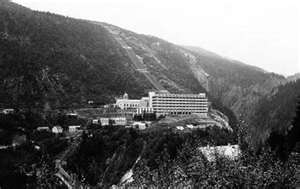 This week in the war, on 9 March 1940 and with the agreement of Norwegian authorities, a team of Deuxieme Bureau (French Military Intelligence) operatives took possession of a stock of heavy water at the Vemork Norsk Hydo plant (shown here) near the village of Rjukan in the Norwegian county of Telemark. Heavy water (D2O) can be used to fuel an atomic pile, such as the one that the Nazis were intending to build in the Black Forest. Such piles can produce the fissionable material required for an atom bomb. The French shipped the heavy water across the North Sea to Scotland and then to France. In June, when France was about to succumb to the German Blitzkrieg, the material was shipped back to Britain.
This week in the war, on 9 March 1940 and with the agreement of Norwegian authorities, a team of Deuxieme Bureau (French Military Intelligence) operatives took possession of a stock of heavy water at the Vemork Norsk Hydo plant (shown here) near the village of Rjukan in the Norwegian county of Telemark. Heavy water (D2O) can be used to fuel an atomic pile, such as the one that the Nazis were intending to build in the Black Forest. Such piles can produce the fissionable material required for an atom bomb. The French shipped the heavy water across the North Sea to Scotland and then to France. In June, when France was about to succumb to the German Blitzkrieg, the material was shipped back to Britain.
Production at Vemork continued, even after the German occupation of Norway in April 1940, and the Allies carried out a series of operations aimed at sabotaging or destroying the plant. Their most spectacular failure was Operation Freshman in November 1942. British commandos were dispatched to Norway in gliders. Both gliders crashed and all aboard were either killed or else captured and handed over to the Gestapo for execution. Unfortunately, one month before, Hitler had issued his infamous Commando Order, requiring all commandos, and units made up of agents or saboteurs, to be killed upon capture—regardless of whether they were in uniform or had surrendered. (British commandos had been experiencing too much success!).
![Vemork sabotage reenactment [Public domain] via Wikimedia Commons](https://secondbysecondworldwar.com/wp-content/uploads/2012/08/Wvemorksabotage-300x225.jpg) In February 1943, a second operation was mounted by Norwegian commandos who were flown from Britain in an RAF Halifax and landed by parachute. This operation, code-named Gunnerside, was stunningly successful. The team entered the factory by a basement window and planted explosives which destroyed the plant’s crucial electrolysis chamber. When the plant eventually resumed production, the Allies responded with air raids, including daylight raids by the United Stated Army Air Force.
In February 1943, a second operation was mounted by Norwegian commandos who were flown from Britain in an RAF Halifax and landed by parachute. This operation, code-named Gunnerside, was stunningly successful. The team entered the factory by a basement window and planted explosives which destroyed the plant’s crucial electrolysis chamber. When the plant eventually resumed production, the Allies responded with air raids, including daylight raids by the United Stated Army Air Force.
Eventually, the Allied bombing raids convinced the German authorities to close down the plant and ship what heavy water had been produced to Germany. However, the barrels of heavy water went to the bottom of Lake Tinnsjo when the ferry was sunk by the Norwegian Resistance. Sixty years later, some of the barrels were recovered. One is currently on display at the American National World War II Museum in New Orleans. Operation Gunnerside and the sinking of the Norwegian ferry became the basis for the 1965 Hollywood movie The Heroes of Telemark, starring Kirk Douglas and Richard Harris. A more recent World War II movie that touches on heavy water, and a film that is one of my personal favourites, is Bon Voyage, directed by Jean-Paul Rappeneau. Camille (played by Virginie Ledoyen) is a physics student during the final days of the fall of France. She and her professor follow the government exodus to Bordeaux and must ensure that France’s heavy water, which they are transporting in their car, is flown to England. The movie is an entertaining mix of romance, comedy, and espionage, and includes a brief glimpse of a general who is obviously meant to be Charles de Gaulle.
